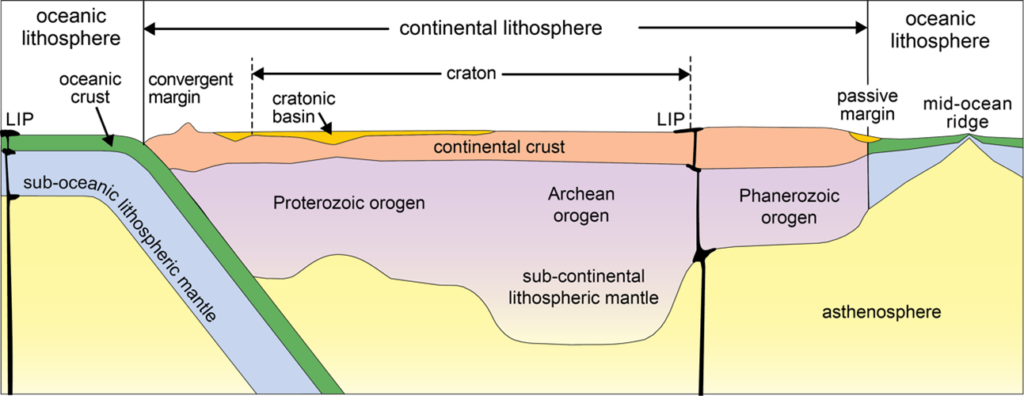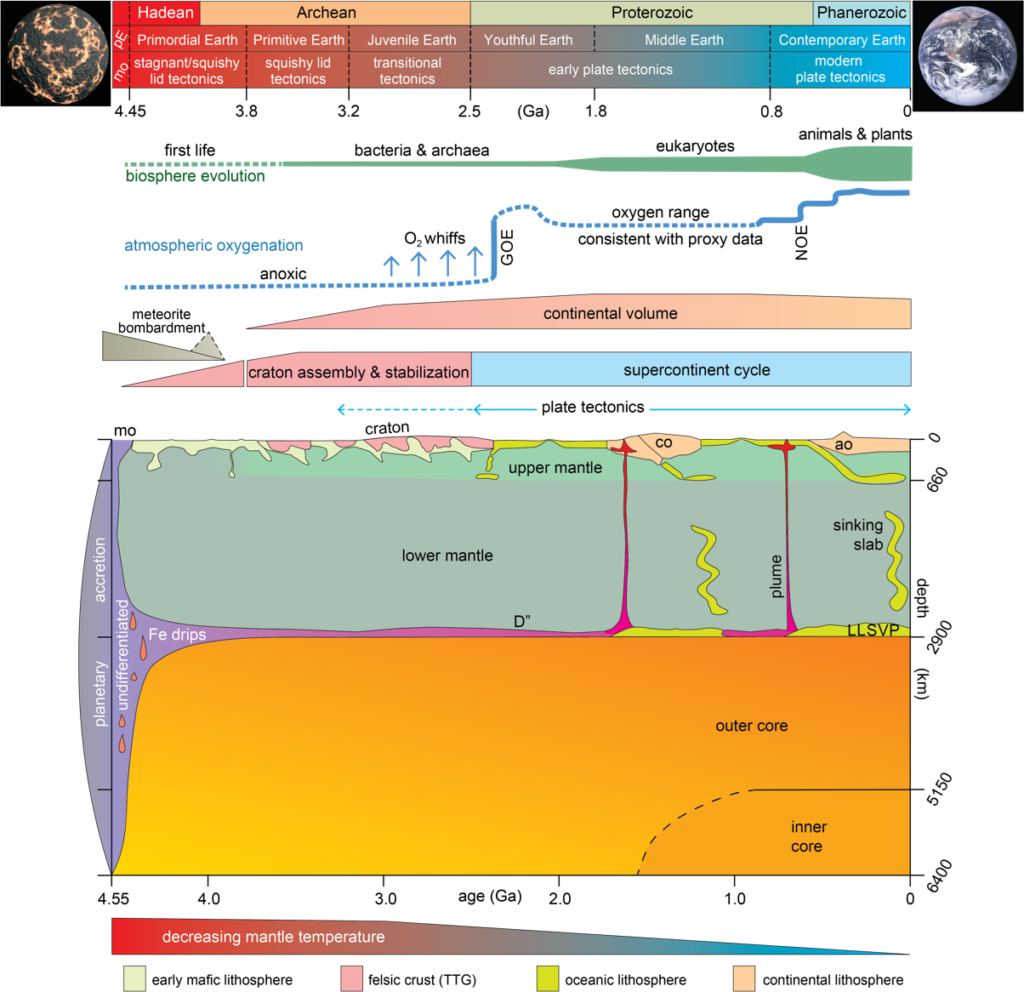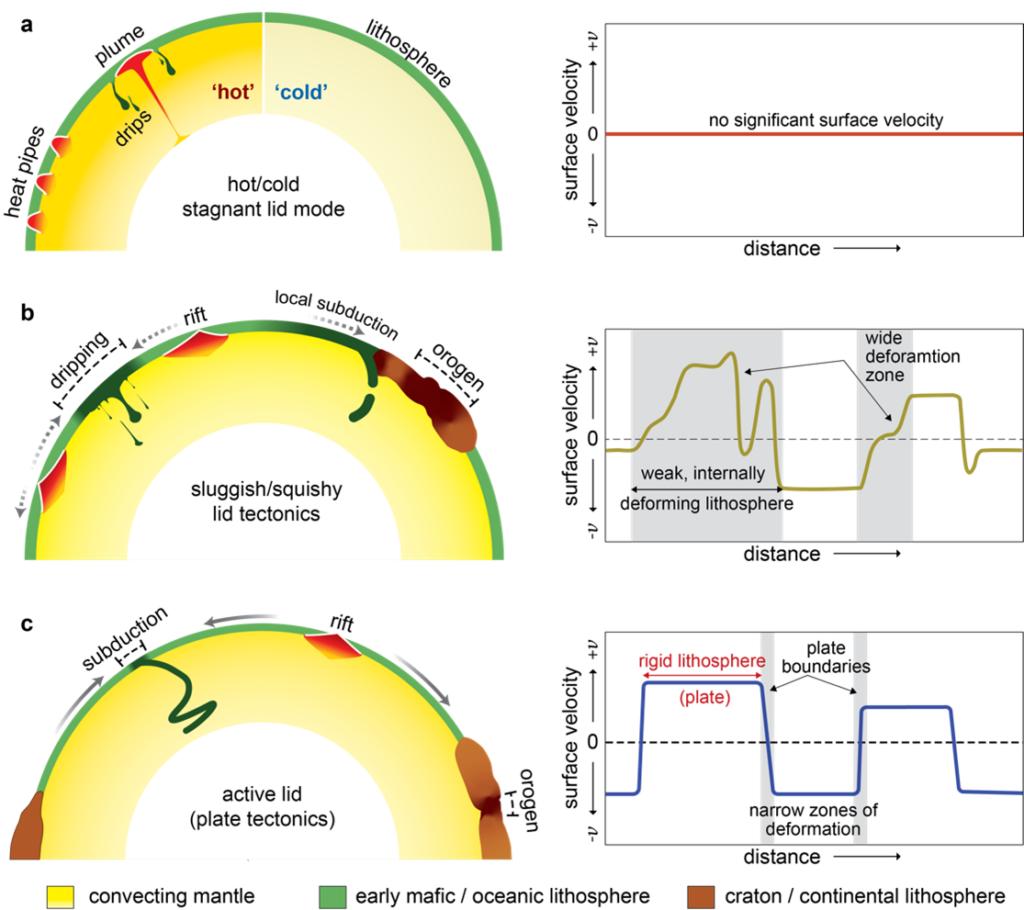Editors’ Vox is a blog from AGU’s Publications Department.
The long-term record of Earth’s evolution is preserved in its continental crust. However, this rock archive is limited, and our understanding of the past decreases with increasing age and depth. A recent article in Reviews of Geophysics uses accessible data preserved in this record to identify seven stages in Earth’s history – each marked by a distinct tectonic style or geological events. We asked the authors to give an overview of the Earth’s lithosphere, what these tectonic modes tell us, and what questions remain.
In simple terms, what is the lithosphere and what can it tell us about the long-term evolution of planet Earth?
The lithosphere is the outermost layer of the solid Earth that stays rigid (mechanically strong) over geological timescales. It is made up of the crust and a part of the upper mantle that does not convect and varies in thickness from less than 10 kilometers at mid-ocean ridges to over 200 kilometers under the thickest continental lithosphere. The rocks of this layer are cool enough to not deform significantly over billions of years unlike the underlying, hot mantle that is slowly deforming over long timescales (leading to convection). Essentially, the lithosphere separates the convecting mantle and core of the Earth from the oceans, atmosphere, and biosphere and acts as an interface for exchange between the deep Earth and surficial regions.
The lithospheric record has so far revealed that the nature and the processes responsible for the development of the lithosphere, as well as the other components of the Earth system, have evolved in response to secular cooling of the mantle since the formation of the Earth about 4.57 billion years ago (Ga).
What are the main types of continental lithosphere and how do each hold a record of change in the crust and mantle?
We typically divide the continental lithosphere into three types: orogens (modern and ancient mountain belts, including cratons), basins, and large igneous provinces. This division is based on the observable physico-chemical features of these lithospheric types, without having any specific connotation to when and how they formed.
Orogens are the key building blocks of continents; they shape much of the rock record and what is preserved. Their history of sedimentation, magmatism, deformation, and metamorphism provide the main record of the formation of continental lithosphere, as well as its subsequent reworking that together led to its long-term stabilization and preservation. Cratons are orogens that have remained stable for long periods after their formation and are found to be mid-Proterozoic or older in age. Large igneous provinces (LIPs) consist predominantly of mafic igneous rock sourced from decompression melting (upwelling) of mantle underlying the lithosphere.
Sedimentary basins form a cover on the other continental lithospheric components and are made up of clastic detritus derived from pre-existing elements, along with chemical sediments and biogenic accumulations. Basin deposits and LIPs are variously incorporated into orogens during tectonothermal events. The processes by which orogens have formed likely evolved through Earth history due to secular cooling of the mantle, which has resulted in an increase in the strength of the lithosphere.

Which part of the lithosphere reveals the best record of Earth’s evolution?
The answer to this question depends on what part of Earth history one is trying to study. The continental lithosphere reveals the long-term archive of Earth’s history. Fragments of the continental crust extend back 4 billion years, and mineral fragments are as old as 4.4 billion years, reaching within 150 million years of the formation of the Earth. Thus, rocks preserved within the continental lithosphere provide the evidence for changing processes across the Earth system, including secular cooling of the mantle, changing processes of lithospheric formation, and evolving compositions of the Earth’s oceans, atmosphere, and biosphere, including the first widespread emergence of continental lithosphere, the oxygenation of the atmosphere, the first records of life and development of different life forms and major extinction events.
In contrast, the oldest oceanic lithosphere is only about 200 million years, covering a little over the past 4 percent of Earth history. However, the oceanic lithosphere provides an exceptional record of the processes of its generation through mid-ocean ridge spreading driving lateral drift of the continental lithosphere, the recognition of which has been fundamental in validating the concept of plate tectonics. In addition, oceanic lithosphere, including its sedimentary cover, provides a detailed record of evolving ocean and atmospheric compositions over their recorded 200-million-year history.

What are the key moments in the history of continental lithosphere identified so far?
There would be four fundamental moments in the history of continental lithosphere that may have changed the course of Earth’s evolution. First was when granitoid-dominated felsic crust (i.e., the continental crust) started to appear for the first time. Although there is debate about the timing of it, current consensus is that it happened sometime during 3.8-3.2 Ga.
The second moment would be when the stable continental lithospheres (i.e., the cratons) developed. Based on the record available, this process may have started at ca. 3.2 Ga and may have continued till the end of Archean (2.5 Ga). This process established the nuclei of continents that later grew and were modified through tectonic processes into their current configuration, on which we are living today.
The third critical moment would be when exposure of continental crust above sea level first became widespread. The timing of this event is also not accurately known but from the sedimentary rocks and isotopic evidence, we think this may have happened some 3.2-3.0 billion years ago and continued till the end of Archean, like the evolution of cratons. The emergence of continental crust kickstarted terrestrial weathering and fluvial runoffs that fundamentally changed the composition of atmosphere and oceans, started providing climate feedbacks, and created new habitats for the proliferation of early life.
The final key event was the formation of supercontinents, involving the cyclic amalgamation and dispersal of continental lithosphere, which is a manifestation of global plate tectonics. Again, the timing of this is debated, but most agree it has operated since the Archean (the last 2.5 billion years), with initial signs beginning in the latter half of the Archean (ca. 3.2 billion years ago).
What are some of the challenges scientists face in interpreting the continental crust?
There are two key constraints on interpreting and understanding the continental rock record. The first is that the record is incomplete both temporally and spatially. Furthermore, the record decreases with increasing age. Thus, the first 500 million years of Earth history is preserved in mineral grains, each less than a 1 mm in length of which only a few thousand have been discovered. Rocks covering the next two billion years of Earth history are limited to cratons and constitute less than 10 percent of the exposed continental crust.
Also, the older crust was variably deformed and metamorphosed during later events which have partially to completely overprinted the original record. This results in uncertainty in interpretations drawn from the record. Thus, there is always doubt and discussion as to whether the preserved rocks are representative of the general processes that operated or is the record selective and biased by the processes of preservation.
What is a tectonic mode and what are the different tectonic modes Earth witnessed as it evolved through time?
Tectonic mode encompasses the geological activities (e.g., magmatism, deformation, metamorphism, sedimentation) that characterize a planetary body at a global scale and is effectively the mechanism by which the body loses heat. Depending upon how actively the lithosphere participates in mantle convection, the following endmember modes are possible: stagnant lid, in which there is no lithosphere-mantle coupling, sluggish lid, involving non-rigid lithosphere and convecting mantle, and active lid, involving strong coupling between lithosphere and convecting mantle.

Today, the Earth operates in an active lid mode, which is referred to as plate tectonics. Both stagnant and sluggish-lid modes are argued to have operated early in Earth’s history and a plausible succession of tectonics modes after accretion from the solar nebular (4.57 Ga), is the following: the Proto-Earth initially consisted of a magma ocean, which crystallized after a few tens of millions of years. The early lithosphere was likely dominated by mafic crust that existed until ca. 3.8 Ga.
The tectonic mode that operated at this time involved either no lithosphere-mantle coupling (cf. stagnant lid) or coupling between non-rigid lithosphere and convecting mantle (cf. squishy lid). This non-rigid lithosphere reflects high mantle temperatures. The latter mode also likely operated through most of the Archean (ca. 3.8-2.5 Ga) and was associated with the formation of the stable interior of continents, known as the cratons. The stabilization of these cratons in the latter half of the Archean (ca. 3.2-2.5 Ga) is associated with the development of rigid lithosphere and the transition to a plate tectonic mode that continues to the present day.
What are some of the unresolved questions where additional research, data, or modeling are needed?
Ongoing issues in the study of the Earth include resolving the tectonic mode(s) that operated on the early Earth and detailing the exchanges and feedbacks between the different Earth reservoirs (mantle, crust, oceans, atmosphere, and biosphere). Continuing study of the other terrestrial planets, especially the potential for sample return missions from the Moon and Mars, along with work on meteorites, will provide much new, albeit statistically limited, data and ideas on the early phases of Earth evolution; for example, much of the surface of Mars preserves an early history of its evolution that has not been reworked by subsequent events, as has been the case on Earth.
Ongoing numerical modeling of mantle processes and refinement of mantle potential temperatures and their secular evolution, along with an improved understanding of mantle convection (whole vs layered) will provide a better framework in which to unravel our planet’s evolution. Furthermore, a better understanding of the processes of intra- and inter-reservoir cycling, together with additional work on the limited pre-3.8 Ga mineral and rock archive, particularly from novel isotopic systems, has the potential to provide new and better constraints on thermal regimes, melting patterns, and lithospheric character and behavior through Earth history.
—Peter A. Cawood ([email protected]; ![]() 0000-0003-1200-3826), Monash University, Australia; and Priyadarshi Chowdhury ([email protected];
0000-0003-1200-3826), Monash University, Australia; and Priyadarshi Chowdhury ([email protected]; ![]() 0000-0001-7544-7331), National Institute of Science Education & Research, India
0000-0001-7544-7331), National Institute of Science Education & Research, India
Editor’s Note: It is the policy of AGU Publications to invite the authors of articles published in Reviews of Geophysics to write a summary for Eos Editors’ Vox.

